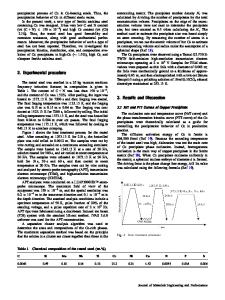Anodic behavior of stainless steel in sulfamate-chloride electrolytes
- PDF / 190,982 Bytes
- 5 Pages / 612 x 792 pts (letter) Page_size
- 103 Downloads / 386 Views
ANODIC BEHAVIOR OF STAINLESS STEEL IN SULFAMATE-CHLORIDE ELECTROLYTES B. I. Bairachnyi, O. L. Smirnova, and V. V. Tovkes
UDC 620.194
We study the anodic behavior of 08Kh18N9T stainless steel in solutions of electrolytes. It is shown that the passive state of steel caused by a dense oxide film is violated in a mixture of sulfamic acid with chlorides. The kinetics of the anodic process is analyzed and the reactions running in the process of dissolution of steel under the conditions of anodic polarization are described.
In contact with corrosive media (acid solutions, ion melts, and gases), the physicochemical processes running on the surfaces of stainless steels can lead to their damage. To prevent harmful consequences, it is customary to use functional metal coatings. In the process of deposition of these (copper or nickel) coatings, it is reasonable to subject steel to preliminary etching with an aim to improve the contact of the coatings with the base. As a rule, in the practice of electrodeposition, nickel–chromium steels are chemically etched in concentrated hydrochloric acid with subsequent nickel plating in a Ni Cl2 solution with elevated concentration of H Cl [1]. The technological operations carried out in these solutions are quite complicated due to their aggressiveness and high toxicity. At the same time, the solutions of sulfamic acid with admixtures of chlorides are much less toxic. Experimental Procedure We study the anodic behavior of 08Kh18N9T nickel–chromium steel in a solution of sulfamic acid (0.5 mole / liter) and sodium chloride (2 mole / liter). Steel electrode plates with a working area of 1 cm2 are degreased in a solution of sodium carbonate (Na2 CO3 ). We study the electrochemical processes in a YaSE-2-type cell with a PI-50-1.1 potentiostat, a PR-8 programmer, and a PDA recording device. The values of electrode potentials are recalculated relative to the normal hydrogen electrode. As auxiliary electrodes, we use lead plates. Experimental Results and Discussion In Fig. 1, we plot the anodic polarization potentiodynamic dependences for steel placed in a solution containing both sodium chloride and sulfamic acid (curve 1) as well as in solutions of sodium chloride (curve 2) and sulfamic acid (curve 3). The stationary potential of dissolution of steel in a solution of sodium chloride is equal to 0.05 V. The anodic polarization of the steel electrode (curve 2) promotes its active dissolution for potentials more positive than 0.45 V. In sulfamic acid (curve 3), steel dissolves for much more positive potentials (higher than 1.2 V). The curve contains both a section of active dissolution and zones of passive and transpassive states. “Kharkiv Polytechnic Institute” National Technical University, Kharkiv. Translated from Fizyko-Khimichna Mekhanika Materialiv, Vol. 42, No. 5, pp. 17–20, September–October, 2006. Original article submitted May 24, 2006. 584
1068–820X/06/4205–0584
© 2006
Springer Science+Business Media, Inc.
ANODIC BEHAVIOR OF STAINLESS STEEL IN SULFAMATE-C HLORIDE ELECTROLYTES
(
Data Loading...











